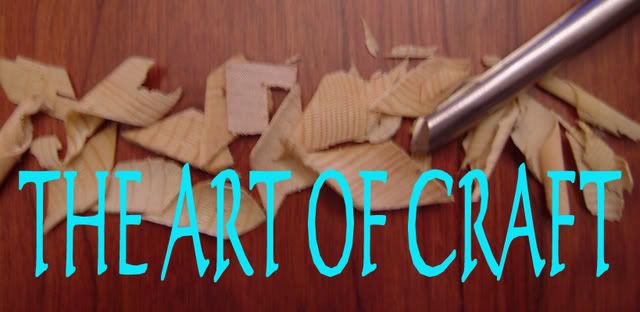In our last article we talked about shooting your product photos outdoors. In this article we are going to move your photo "studio" indoors. There is more to shooting inside than putting your item down on the kitchen table and taking out your camera. Believe me, I have tried it when I have been in a hurry and there are always problems.
When shooting indoors there are three things that must be taken into consideration - lighting, shadows, and background. If you control these three things you will easily take good product photos.
While you do not have to dedicate a space for your photos full time (who has room for that?) you are going to want to determine a space that you will always come back to when you need to take photos. Look around your house - or apartment - and find a space that you can take over for the times when you need to take photographs of your craft or art work. This space needs a table or counter that is already there all of the time or a place to put a small folding table. The height of the table needs to be comfortable for you to work on so a low to the floor, living room, coffee table is not ideal. Your kitchen table will work. The table on which you create your craft will work (as long as you don't keep your tools out all of the time - you don't want to need to completely clean up and put everything away every time you need to take a photo. If you do and you are like me, you will never take any photos.) Find your space and use that space every time.
Now to start controlling each of the three variables mentioned above. First let's talk about lighting. If you see a picture of a professional photographers studio you will see that several lights are used to light the subject. Look closely at those lights and they usually are facing away from the subject and there are reflective umbrellas in front of them which bounces the light toward what or who they are taking the photo of. They do this to get indirect light focused on the subject. Another method (more used years ago than now) was to put translucent covers on the front of the lights. Indirect light or diffused light provides a soft light that will not create a glare on what you are photographing. Generally, these photographers are not using a camera flash pointed at the subject because the flash will cause a glare as well. So you want to create a situation where you can get good light on your item that is not pointed directly at it and not use your camera flash. Digital cameras can adjust to take photos with very little light. Two problems can result from that - one is that it will set the speed that your shutter opens and closes too low - so the very slightest movement will cause blur - and the second is that the camera will change the ISO setting to one that is so high that small blotch spots will result on your image called "grain". When cameras more commonly used film, the film would be sold to work at a certain ISO setting. You would set your camera to what the ISO setting was on the film box. Then as now, the higher the setting and the lower the light, the more likely you would get grain on your photos. Technology on digital cameras has pushed the level way up from what film settings will result in, but as you approach 1000 ISO and beyond you are going to have to deal with grain. Some image software has corrections for grain, but none really work as well as taking your photo correctly to start. For product photos leave your ISO setting on "AUTO" and let the camera handle it. As long as you are providing the right light this will not be an issue. Your tripod and a steady hand pushing the shutter button will stop the blur from a low shutter speed. But again, sufficient light makes this problem go away.
So what are you going to do about light. Your room lights may cause you a problem. Ceiling lights too close to your shooting space can cause an overhead glare. Try to offset your photo space out from under overhead lights. You are going to need lights to take your photos. No, you don't have to spend a lot of money. The cheapest way to deal with this is to purchase clip on utility lights at a home or discount store. These lights sell for about $6.00 each and use regular household light bulbs. The lamp has a metal clip on the bottom and a large, round, metal hood around the bulb. I use incandescent light bulbs but you could use the new twist shape fluorescent bulbs that everyone thinks are so wonderful right now. Let me caution you right here - those bulbs are EXTREMELY dangerous if they break. Read the package. You are supposed to deal with the broken bulb and the room as if a hazardous substance spilled. I am not going to get into this now, but use incandescent light bulbs in your photo lights. You are going to be moving them around and there is too much risk that something is going to fall and break and you do not want to be dealing with that so called "green" bulb if it breaks. You are going to want at least two lights. As you read further you will see why you might want three.
You are going to need to be able to clip these lamps to your table in front of the spot that you are going to place your item - one on each side. By directing the two lights you can eliminate one of the the other variables above - shadows. Two lights with their beams or light crossing each other will eliminate shadows. When two don't do it, a third light from above added into the mix usually will. Set your item down - on its photo display (just like we talked about in the last article) and start moving your lights so that there are no shadows and no glare - and, obviously, so that the lamps are in no way in the picture. Now, I talked about indirect or diffused light - we'll get back to that.
Let's move, for a moment, to the last variable - background. Look behind your item and what do you see. Whatever it is, it is going to be in your picture in some way - even if it is blurred out. Look down at your table under your item and what do you see? That too is going to be in the image. You can also get glare coming up from the table top. Let's do something about that first. A neutral solid color piece of fabric makes a nice "table" cloth to go under your item. Some colors work better than others. Avoid white because you are going to struggle more in correcting the white balance of the cloth in the picture than of the item. Light blue is good. Light grey is good. Light tan is good. If your item is very light in color you might even want to use black. I like to use flannel. It gives a softer look to the cloth when photographed - and it is inexpensive in fabric stores. It will also absorb light rather than reflect the light - which is something that you want when you are looking to avoid light where you don't want it or that you cannot control. As to what is behind your picture... A cloth backdrop works well here too. Again, the same solid colors in a cotton flannel are recommended. Do not use a pattern. Remember, you want to focus attention on the item - not what is behind it or around it. A pattern - even a subtle one will bring the eye away from the item. Attach the cloth to a board that will stand at 90 degrees to the table - and won't fall over. You can purchase corrugated plastic in many craft and hobby stores in poster size sheets. It is easy to cut with a razor knife and you can attach your fabric to it. Cut it down to a managable size but large enough to fill the background of your photo in the space that you are working in. Use the remaining plastic board to create a stand - much like the ones that you find on the back of table picture frames.
You now have your space set up. You know how to but it up and take it down - and more importantly you can put it up exactly the same way the next time that you need it. Set your item in place and start moving your lights so that you have no shadows either on the background or on the table. Now I am going to repeat what I wrote in the second article - At this point you are ready to shoot and all you need to do is swap your items in and out of this position on your table to take your photos. Set up your tripod in front of the object (or get into a comfortable position with your Optically Image Stabilized camera with no need for a tripod), set your camera to Macro mode, set your white balance to sunlight, and check the distance that you are from your object. If you are within the macro range specified for your camera then you are ready. If not, then move your tripod or yourself to where you need to be. You might even want to use a ruler or tape measure to make sure you are where you must be. Check each photo on the screen of the camera as you shoot each shot - look closely and you will see if you are ok or you need to make an adjustment. Always take several shots of each set up object. It costs you nothing and it is all disposable and you are only limited by the size of the memory card in your camera.
All of this will work, but this set up has its pitfalls. There is a much simpler way to accomplish all of this. For just a small expense you can get yourself a light tent. And that will be discussed in the next article - when we also get back to all those things that I said I would get back to.
To be continued...
Subscribe to:
Post Comments (Atom)













3 comments:
GREAT TIPS - Thank you so much for sharing! Just followed your blog - I love it!
This is such a helpful topic for Etsy sellers. So many of us struggle with taking good photos.
Nice blog, you can find some more Ceiling Lights.
Post a Comment